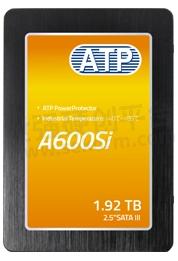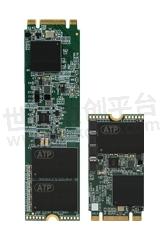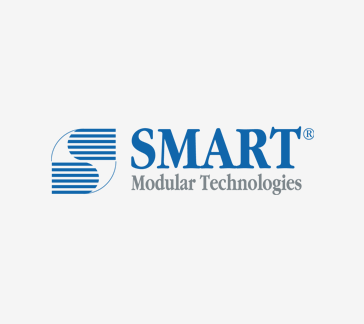ATP Offers Typical SSD Form Factors, NAND Flash Technologies and Interfaces




Getting to Know the SSD Inside Out
In enterprise data centers and industrial environments where workload demands are high and the speed of data access is crucial, solid state drives (SSDs) are increasingly becoming the storage of choice.
What is an SSD? How can you choose the right SSD for your project to yield reduced total cost of ownership (TCO)? First, let us look under the hood and see what makes it work.
The Inside Story
An SSD and a hard disk drive (HDD) serve similar purposes— they are storage devices. Unlike an HDD, however, an SSD has no moving parts. It does not save data on magnetic platters, and there is no head rotating over the platters to read or locate data.
What is inside an SSD and how does it do what it is supposed to do?
Flash Controller
The flash controller is the heart and brains of the SSD. It is responsible for interfacing with the host computer and the other components of the SSD. When a host computer wants to send data to the SSD, the flash controller directs the flow of data to ensure its reliable storage and retrieval. It also contains the firmware that manages the SSD and performs background processes such as managing the flash file system, wear leveling, error correction, trim, and garbage collection.
This is a small amount of memory that is used as temporary storage of data. It is not available in all SSDs. Because it is volatile, it requires power to retain information. Firmware in the controller decides when to flush or move the data from volatile (non-persistent) memory to the non-volatile (persistent) flash memory. In the event of an unexpected power loss, data in the cache could be lost or corrupted unless an effective power failure protection mechanism is available.
Non-Volatile NAND Flash Memory
Data is persistently stored in and retrieved from NAND flash memory chips. They are non-volatile because they retain data even when there is no power to the SSD.

Figure 1. Main components of an HDD and SSD. (Images are not to scale.)
NAND Flash Memory Types
NAND flash memory is essentially categorized based on how much information each chip can store. Single level cell (SLC) stores only one bit of information on each cell. Multi-level cell (MLC) holds more than one bit of information, though it is commonly associated with two-bit memory. Triple level (TLC) and quad level (QLC) cells, as the names imply, store three and four bits respectively. For a comparison of the main NAND flash types, please click here.
On top of the standard types of NAND flash memory, ATP implements a new advanced firmware technology called "SLC Mode," which allows MLC flash to act as SLC at accessible price points without compromising performance, endurance, capacity and data retention.
Beyond Conventional NAND Flash Labels
The more bits a cell can hold, the bigger the storage capacity. It is common to think that as more bits are crammed into a cell, error rates also increase, causing reliability and longevity to decrease. However, thanks to major headway in storage technology, people are no longer sticking to conventional labels. Economical options that were once relegated as mediocre choices can now have better performance, longer endurance and greater reliability due to powerful controllers, advanced firmware, robust error correction mechanisms, and meticulously screened components, along with stringent testing, validation and manufacturing practices.
ATP builds its products from the ground up, thoroughly screening components from the wafer and IC level to packaging and design all the way up to device/module level testing and validation, so customers can have peace of mind that only the choicest, premium products come out of ATP's manufacturing facilities. All ATP products are made for mission-critical applications where high levels of performance, reliability and endurance are required while maintaining low TCO and generating high returns on investment (ROI).
Getting Connected
An SSD connects to the host using an "interface," which adheres to a specific "protocol." Interface refers to the hardware transportation layer including voltage, current, and physical pin definition, while protocol refers to the set of rules, standards, command sets and drivers between the storage and the operating system. The choice ofinterface will determine the amount of data that can be transmitted within a period of time (bandwidth), the delay before data transfer actually begins after the transfer instruction is sent (latency) and the capability to expand the system or network to adapt to growing workloads (scalability). It will also determine whether your SSD will have hot-swap or hot-plug capabilities. All of these are important considerations in enterprise usage.
Briefly described below are commonly used SSD interfaces.
Serial ATA (SATA)
SATA is currently the prevalent interface for connecting an SSD to the host. It affords the convenience of being used interchangeably with SATA-based HDDs. Transfer rates for first-generation SATA began at 1.5 Gb/s, and the latest generation, SATA revision 3.0, provides a native transfer rate of 6 Gb/s. SATA uses the Advanced Host Controller Interface (AHCI) command protocol, which was designed for slower mechanical drives with spinning disks.
PCI Express® (PCIe®)
Though PCIe was originally designed as an interface for linking motherboard-mounted peripherals like graphics or wireless network cards, its excellent features for scalability, minimal latency, high bandwidth, and high performance makes it an emerging interface favorite, enabling SSDs to blaze past the SATA III limitation of 6 Gb/s transfers. The interface specification optimized for NAND flash and next-generation solid-state technologies is known as NVM Express® or NVMe™. NVMe delivers twice the performance of SAS 12 Gb/s and four times the performance of SATA 6 Gb/s.
Serial Attached SCSI (SAS)
SAS is designed for high-performance enterprise requirements and is backward compatible and interoperable with earlier SCSI technologies as well as SATA, so a SATA drive can be attached to a SAS port; however, a SAS drive cannot be plugged into a SATA port. SAS doubles the SATA transfer rate (up to 12 Gb/s), delivers better data integrity than SATA, and supports dual-port operation.
Form Follows Function
"Form factor" refers to the size and physical configuration of a device. Initially, SSDs were seen as HDD replacements and came in HDD sizes such as 1.8", 2.5", 3.5" and 5.25". In late 2010, SSDs consisting of flash chips and controllers attached to a circuit board were used in ultra-thin mobile computers. These SSDs were long, thin and narrow, and had no enclosure. Choosing the right form factor is important, as it defines whether it fits in the system chassis, how many can fit, and if it can be replaced without powering off the system (hot-plug/hot-swap functionality).
Below are typical SSD form factors available from ATP.
Traditional HDD Sizes

SSDs with enclosure come in 1.8" for removable ultra-mobile applications, 2.5" and 3.5" for desktop and enterprise systems, and the less common 5.25" for special-purpose appliances like backup devices. ATP's 2.5" industrial SSDS with the SATA III 6 Gb/s interface are shock resistant and can operate in a wide range of temperatures, making them ideal for enterprise and industrial applications requiring outstanding performance, endurance and reliability amidst rigid operating conditions.
Solid State Modules

M.2 NVMe

M.2 SATAs
Flash memory chips reside in a dual in-line memory module (DIMM) or similar form. They may use a standard HDD interface like SATA.
The M.2 standard provides higher performance and capacity while minimizing module footprint. M.2 modules connect either via SATA or PCIe, come in multiple widths and lengths, are available in soldered down or connectorized type, and can have single- or double-sided components. All soldered down modules are single-sided and are intended to be used in low-profile applications. (Note: M.2 modules are neither hot-swappable nor hot-pluggable.)
ATP M.2 NVMe SSDs fit into a PCIe 3.0 x4 slot, offer up to 1 TB capacity, and deliver a bandwidth of up to 32 Gb/s (8 Gb/s per lane), which is four to six times the data transfer speed of the previous-generation AHCI protocol on Serial ATA drives.
ATP M.2 SATA SSDs deliver high-performance SATA 6 Gb/s and adopt the double-sided configuration to enable higher densities. They come in three sizes: 2242, 2260 and 2280.
mSATA

Just roughly the size of a business card, an mSATA SSD adopts the PCI Express Mini form factor and connector. Though it can easily be mistaken for a PCIe mini card, an mSATA SSD signaling conforms to the mSATA standard, which is based on the SATA storage interface supporting maximum data transfer rates up to 6 Gb/s. It plugs into an existing PCIe Mini card slot but will function properly only if connected to a SATA host controller. Compatible slots will be labeled as either dedicated for mSATA or shared with PCIe mini. A PCIe Mini card installed on a dedicated mSATA slot will not function properly.
SlimSATA

Also called Half-Slim SATA, a SlimSATA SSD uses a 22-pin SATA pin connector, the same connector used on 2.5" SSDs. ATP SlimSATA SSDs are high-performance and reliable mass storage devices featuring an advanced wear-leveling algorithm for enhanced endurance.
Flash Memory cards

Memory cards also use flash memory and are used either as removable or embedded storage. ATP's industrial flash memory cards are built for rigorous computing conditions in automotive applications and industrial environments. They feature advanced wear leveling and data integrity protection features and can withstand harsh operating environments with severe temperatures ranging from -40℃ to 85℃. Flash memory cards in ATP's portfolio include SD/SDHC/SDXC, microSD/microSDHC/microSDXC, CFast, and CompactFlash (CF) cards.
Embedded USB (eUSB)

An embedded USB module complies with the Universal Serial Bus (USB) standards. It is commonly used as a boot drive for systems and applications. ATP eUSB modules are ideal for industrial and rugged environments. Advanced wear leveling ensures long usage life and ATP PowerProtector completes the last read/write operation during a sudden power loss event, so data is safely stored to the NAND flash.

A USB drive, also known as a USB stick, thumb drive, pen drive, or USB flash drive is a flash-based storage device that connects to the host via a USB interface. While commonly used as external removable storage, USB drives are now also being used in embedded industrial applications, mainly as boot drives. ATP Nanodura ruggedized industrial USB drives are suitable for mission-critical computing with their tough metal housing, which enables them to withstand extreme temperatures from -40°C to 85°C as well as resist water, moisture, dust, shocks, vibration, electrostatic discharge and other environmental strains.
ATP Advantages
While it is common and helpful to choose SSD solutions based on NAND flash types, capacities and interfaces, endurance and reliability must also be considered to guarantee dependable operation over long periods of time. In industrial applications, devices often function under heavy workloads, extreme temperatures and harsh environments with dust, humidity and other external hazards. It is therefore important to go for a trusted manufacturer that takes control of every manufacturing process to ensure quality and steady supply.
As an established memory and storage manufacturer with over 25 years of expertise, ATP is committed to the highest quality of products and services. Here are their key differentiators
Strategic Partnerships ensure product longevity, supply stability, technical support, and smooth qualifications and transitions.
Process Ownership. ATP maintains complete control of its supply chains and takes charge of all stages of the manufacturing process from NAND characterization, wafer management, package-level validation and NAND flash screening all the way up to mass production.
NAND Self-Packaging Capability using high-quality Full-Grade ICs sourced 100% from Tier 1 manufacturers.
Rigorous Testing and Validation from IC to Module and MP Levels ensure the reliability of all flash products.
ATP-Owned Manufacturing Facilities with state-of-the-art production, testing and inspection equipment.
- |
- +1 赞 0
- 收藏
- 评论 0
本文由涂抹转载自ATP Blogs,原文标题为:SSD Form Factors, NAND Flash Technologies and Interfaces,本站所有转载文章系出于传递更多信息之目的,且明确注明来源,不希望被转载的媒体或个人可与我们联系,我们将立即进行删除处理。
相关研发服务和供应服务
相关推荐
ATP‘s Power Loss Protection Just Got Smarter with MCU-based SSD Design
ATP customers want constant assurance that power loss events will not cause massive downtime or lost data that could affect business operations and lead to higher operating costs. The MCU intelligently monitors sudden power failure conditions from a glitch to a surge or a complete outage...
The ATP Gym and Coach System: Exercising SSDs to Ensure Total Fitness
With the Gym and Coach system, ATP has dramatically improved RDT and the initialization process for functional test details. By making industrial SSDs undergo a lot of “painful” exercises through stringent testing, ATP makes sure that customers have everything to gain by receiving the most robust, reliable and enduring flash storage products for their applications.
FORESEE 1.8 V SLC Parallel NAND Flash, in Line with Industrial-Grade Temperature Requirements, Accelerated Longsys’ Expansion into the 5G Market
Longsys‘ FORESEE industrial-grade storage product line launched the 1.8V SLC Parallel NAND Flash, to provide necessary data storage applications for electronic devices. The product meets the industrial-grade temperature requirements of -40℃ to 85℃.
SMART(世迈科技)DuraFlash™闪存产品选型指南
目录- Company Portfolio/Products Applications Flash Storage Product Introduction 2.5” SATA M.2 SATA mSATA Slim SATA M.2 PCIe NVMe U.2 PCIe NVMe EDSFF / U.2 PCIe NVMe (Enterprise and Data Center SSDs) BGA eMMC 5.1 Memory Cards CF Cards/CFast Cards eUSB Flash Drives/USB Flash Drives RUGGED SSD LINE-UP
型号- N200,R800,RU350,SP2800,S5E,RU150,T5E,M4,R800V,BGAE440,S1800,BGAE240,RD130M,ME2,M1HC,H9 CF,M1400,HU250E,M4P,T5EN,T5PFL,RU150E,N200V,T5PF,RD230M,MDC7000,XL+,RD230
ATP(华腾国际)DRAM存储模块和NAND闪存产品选型指南(英文)
目录- Company Profile Segment Challenges and Solutions Thermal Solutions Endurance Solutions Security Solutions CFexpress & USB 3.0 Value Line SSDs DDR5 DRAM SOLUTIONS FLASH SOLUTIONS Flash Products Naming Rule Solutions & Technologies Flash Technology Overview table Complete Flash Spec Overview & Product Dimensions
型号- A750PI,E650SC SERIES,S600SC,B800PI,S750 SERIES,S600SI,S600SCA,E750PC SERIES,B600SC,N700PC,S700SC,E650SC,A750 SERIES,E600VC,S800PI,A750PI SERIES,I800PI,A600VC,A650SI,A650SC,N700 SERIES,S650SI,N750,N750PI,A800PI,A700PI,N700SI,N650 SERIES,E600SAA,N700SC,A750,N600SC,A600VC SERIES,E600SA,E650SI,E650SI SERIES,N750 SERIES,E700PIA,TR-03153,N600SI,S650,S650SC,E700PAA,N650SIA,E600SI,B600SC SERIES,S750SC,S600SIA,I700SC,N650SI,N600VI,E600SIA,E750PI,N650SC,N750PI SERIES,N600VC,I600SC,E750PC,S700PI,A650 SERIES,N650,N600 SERIES,N600VC SERIES,S650 SERIES,A650,AES-256,E700PI,A600SI,E750PI SERIES,N700PI,E700PA,S750,S750PI,E700PC,A600SC
宇瞻(Apacer)工业用SSD选型指南
描述- Apacer is a global leader in digital storage solutions, and is devoted to innovative storage technology and services. The company focuses on embedded applications for a variety of vertical markets, including military, medical, gaming, and industrial, and has become an integration expert in digital storage, innovative applications, and value-added services.
型号- UV110-UFM2,SDM7-M 7P 180D LP2H,UV110-UFM1,SM22P-CFAST,SDM5A 7P/180D LP2,US120-UFD5,SM21P-25,UV110-UFD5,SV25C-M242,INDUSTRIALSD R1,EH353-M,PT220-M280,UDM2A-M,SDM5A-M 7P/90D LP,SH250-M280,SV250-CFAST,SDM5A 7P/180D SLIM2,PV930-M280,SDM5A 7P/90D LP,SU210-25,CF6,CM710-CF,PV210-M280,SDM5A-M 7P/180D SLIM2,INDUSTRIAL MICROSD R1,SV25C-25,ST250-300,INDUSTRIAL SD H1-SL,SH24D-M280,SV250-25,SH250-25,SM230-M280,UH110-UFM1,SH24D-25,SU230-CFAST,SH250-300,SDM5A-M 7P/180D SLIM2H,ADM5S-M,SV170-ΜSSD,CS710-CF,SV250-M242,EH353,SDM5A 7P/90D LPH,PV220-M280,UDM 1U-M,PV140-25,ST250-M280,CF6A,PV910-M280,SH24D-300,ADM5S,INDUSTRIAL SD H1-M,SDM5A 7P/180D SLIM2H,ST250-25,PV920-M280,SV25C-M280,SDM7-M 7P/180D DP,SDM7-M 7P 180D LP2,SS210-300,SS220-M242,AH322,SH250-CFAST,EH163-M,AH321,UDM2A,SDM5A-M 7P/180D LP5,SH250-M242,INDUSTRIAL SD,SDM5A-M 7P/90D LPH,UH110-UFD4,SU220-CFAST,UM120-UFD5,SV240-297,INDUSTRIAL MICROSD H1-M,SDM5A-M 7P/180D LP5H,AFD257-M,CV110-MSD,CH110-MSD,SV250-7LP2/180D,SV25C-300,SM210-25,CH110-SD,SV250-300,ST250-M242,USZ20-UFD5,CV110-SD,SV240-M280,CH710-CF,AFD257,SV240-300,SS220-CFAST,PH920-M280,SV250-M280,SM230-CFAST,SS210-25,SLC-LITEX,SM230-M242,CH120-MSD,INDUSTRIAL MICROSD H1-SL,CF6-M,SM210-M280,PV22D-M280,CF6A-M,UV110-UFD1,UDM 1U,PV910-M242,PV910-CFX,INDUSTRIAL MICROSD,SV240-25,ST250-297
ATP Launches Its Tiniest PCIe Gen3 x4 NVMe™ SSDs in M.2 Type 1620 HSBGA Package
ATP Electronics, the global leader in specialized storage and memory solutions, has announced the launch of its tiniest NVMe flash storage offering: the N700 Series PCIe® Gen3 x4 NVMe™ solid state drives (SSDs, which are available as M.2 Type 1620 heatsink ball-grid array (HSBGA) package.
Bringing 3D TLC NAND Flash Endurance and Reliability Closer to SLC/MLC
The advent of 3D NAND technology allowed for more relaxed lithography and broke planar NAND limitations. By stacking cells vertically, 3D NAND flash increased drive reliability and endurance. ATP breaks new ground with its new 3D TLC-based SATA SSDs.
SMART Modular Introduces Ruggedized, High-Speed, High Capacity, High Security T6EN SSDs for Aerospace, Defense and Industrial Applications
SMART Modular Technologies announced its new ruggedized T6EN PCIe/NVMe flash drives for aerospace, defense, and industrial applications. This new family of SSDs is available in U.2, E1.S and M.2 2280 form factors, enabling flexibility for end users based on their specific application and configuration needs.
How Over-provisioning Improves NAND-based ATP SSDs’Endurance and Performance
Over-provisioning (OP) provides additional space for garbage collection process of solid-state drives (SSDs), aids in improving the performance, and increases their endurance, hence contributing to extended drive life. This article ATP provides an in-depth view of OP and how its size affects the terabytes written (TBW), along with random write performance of SSDs.
DRAM-less Value Line SSDs Available in I-Temp/C-Temp Operable Models
型号- A600VC SERIES,N600VI,A600VI,A600VI SERIES,A600VC,N600VC SERIES,N600VC,N600VI SERIES
SMART’s DuraFlash CS210 SATA 2.5” Solid State Drives are Designed for General-purpose Industrial Applications
SMART’s DuraFlash CS210 SATA 2.5” solid state drives are designed to meet the demand for a cost-effective solution in general-purpose industrial applications.
A750/A650, N750/N650 Series: New-Generation 3D TLC SSDs Deliver Near-SLC/MLC Endurance
型号- N750,A750PI,N750 MODEL,N750PI,N650 MODEL,N650,A650 SERIES,N650 SERIES,A750 SERIES,A650,A750,N650SI,N750 SERIES,N650SC,A650SI,A650SC
电子商城
现货市场
服务
可烧录MCU/MPU,EPROM,EEPROM,FLASH,Nand Flash, PLD/CPLD,SD Card,TF Card, CF Card,eMMC Card,eMMC,MoviNand, OneNand等各类型IC,IC封装:DIP/SDIP/SOP/MSOP/QSOP/SSOP/TSOP/TSSOP/PLCC/QFP/QFN/MLP/MLF/BGA/CSP/SOT/DFN.
最小起订量: 1 提交需求>
拥有IC烧录机20余款,100余台设备,可以烧录各种封装的IC;可烧录MCU、FLASH、EMMC、NAND FLASH、EPROM等各类型芯片,支持WIFI/BT模组PCBA烧录、测试。
最小起订量: 1 提交需求>





































































































































































































登录 | 立即注册
提交评论